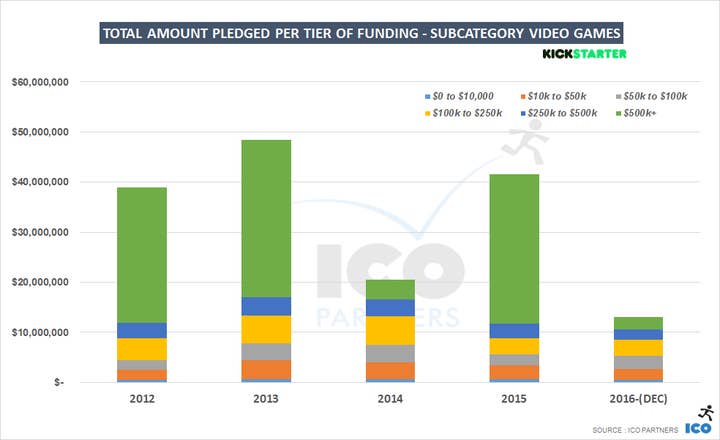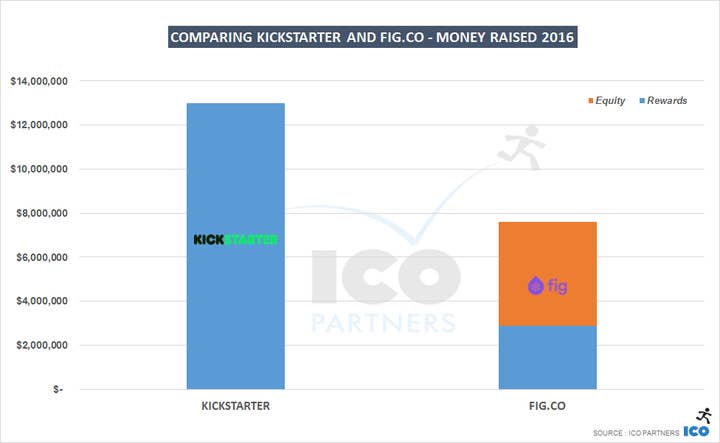Did crowdfunding survive 2016?
Fig raised $8m of the $20m in gaming campaigns this year - was it enough?
The following article is part of a series of daily year-end content on GamesIndustry.biz analyzing the most notable news and trends we've observed over the last 12 months
A year has passed since the last time I did a review of crowdfunding and video games, and it is time another a look at this space.
With data for most of the year (all the projects that got funded prior to the 1st of December are included) the picture that we can draw is pretty representative of the past year, with no real surprise expected before the change of the year as this is a traditionally slow period for crowdfunding.
A new challenger has entered the game
The domination of the video game category by Kickstarter amongst crowdfunding platforms has always made it very easy to track the trends for the sector. By looking only at Kickstarter, you could get a definitive idea of how well crowdfunding is doing for video games.
This year however saw the first real steps of Fig.co and its crowdfunding platform dedicated to video games, with some significant successes. While Fig only represents a very tiny number of projects with 6 funded projects compared to more than 300 on Kickstarter, 35% of the money raised through crowdfunding was raised on the Fig platform.
Looking at crowdfunding for video games as a whole, adding Fig to the global number makes a lot of sense, and below you can see the estimated amount raised, by successfully funded projects on both Kickstarter and Fig over the years.

2016 has not been an impressive year when it comes to the amount of money poured into making video games via crowdfunding. The total amount is just past the $20m mark, a little bit better than in 2014 which had been the worst year for crowdfunding and video games since Double Fine Adventure put crowdfunding to the forefront in early 2012.
Looking at the number of projects for the past year compared to the previous ones shows an interesting trend:

For the time since Kickstarter opened in 2009, there has been fewer projects that tried to get funding on the platform. Moreover, this is the lowest it has been since 2013, the first year with a bit more than 1,800 video games project seeking funding there.
The total number of funded projects though, while declining a little, is staying in the same ballpark number from last year, with 325 projects funded so far, compared to 380 projects on the entirety of 2015. What is new is the range of funding of those projects compared to the previous years.

We already knew that 2016 was a slow year for the crowdfunding super hits, with only 3 projects on Kickstarter (and 2 on Fig) passing the $500,000 mark, but more interestingly, this is the first time that we see fewer projects in the $0 to $10,000 range getting funded, whereas last year's decline in projects was across the board on all ranges, with the exception of the lowest range.
In parallel, there has also been a decline in the number of "junk" projects (projects that raise $0 in total) and general decline in the number of creators seeking funding for a video game. It shows that crowdfunding is probably now perceived as an exercise where it is not that easy to succeed, which might have had an impact on the decline of the total number of projects that were funded in the lowest range.
Another explanation might be that more projects managed to raise enough to take them to the next band of budget. Despite an overall decline in numbers across the board, less money raised, and fewer projects funded, the number of projects raising between $50,000 and $250,000 has stayed at the same level.
Fig numbers
Fig has had a very good first year, having raised close to $8m on its own, but there a number of fundamental differences between the way it works and how Kickstarter operates that require a closer look.
I have been meaning to do a deep dive into Fig and its crowdfunding system for some time now, and while this is not it yet, I will discuss a bit more about the overall numbers for this year.
Fig as a crowdfunding platform uses a mixed system. Where Kickstarter is known as a "for rewards" platform, Fig offers to fund projects both using a "for rewards" approach as well as a "for equity" option. Each method contributes to the total amount raised, with the funding objective being agnostic to the method of funding.
Only a dozen projects went to Fig to seek funding, but already certain patterns have emerged and Fig is proving to be excellent at raising funds on the project equity formula. All the projects that got funded received more than half of their funding, with the exception of Psychonauts 2 that sits very close to a 50/50 split between rewards and equity.

In 2016, 62% of all the funds raised on Fig were done via their project equity solution. This is a significant amount of money that would not have been brought to the projects if they had been on Kickstarter and a new source of funding, or at least a new way to tap into this source of funding, that wasn't there before.
This is not to suggest that Fig is offering a solution that could eventually entirely take over from Kickstarter. Looking at Fig's projects and comparing similar ones that went to Kickstarter, there are signs that Kickstarter is much better at raising money with the "for rewards" model. It might be because they have the better brand recognition, or because the mixed model is off-putting to some backers, nevertheless, at the moment, both platforms present different strengths for game studios. They essentially appeal to different projects, as well as to different creators in the video game sector.
Looking at 2017
Crowdfunding is certainly not growing, and while it hasn't collapsed either, there are certainly questions hanging over its future.
A significant challenger for the model is the option for studios to go to Steam Early Access. Over time, crowdfunding campaigns have become more and more sophisticated and rich. As John Romero discovered in April, it is not possible anymore to get funded if you don't have a demo, or at least some gameplay to preview. The minimum required to launch a successful campaign is such that, for certain projects, by the time you have built the necessary elements you are not far from having what you would need to launch on Early Access, with the added benefit of not having to stress about having to meet a certain goal in a specified timeframe, and the promise of an ongoing revenue stream past the first month. The prospect of failing your campaign is also a very scary thought when you have this other option available. But I can't help and wonder if it wouldn't be better sometimes for some projects to actually fail in a crowdfunding campaign, learn from that experience and have the ability to correct any of the mistakes they have made, rather than try to launch their game without that prior experience and finally have fewer options to correct course.
It would certainly be nice for video games to find their place in the crowdfunding platforms in the way that boardgames have in the past few years, with more projects getting funded every year, and passing $90m raised on Kickstarter in 2016.
If Star Citizen alone managed to raise another $30m this year, it means that the potential for crowdfunding video games has certainly not been fully realised.
Disclaimer: All the data in the piece have either been collected manually on the different platforms, or automatically in the case of Kickstarter, using tools proprietary to ICO Partners and Potion of Wit. Treat all of them as estimates.